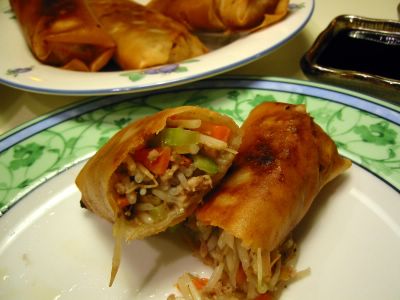 The current theme of the eighth Lasang Pinoy, hosted by the lovely Iska of Edible Experiments, is centered on food for/by children. I wanted to create my husband's favourite childhood snack of bibingkang malagkit but my recipe fell short of expectations. The bottom - soggy, the top - too sweet. Maybe I'll blog it some other time. So off I went recruiting my kids in making a very simple Filipino steamed cake - puto. Mind you this is not your regular traditional puto which is made of malagkit (sticky rice) flour. This is of recent provenance, probably as early as the 80s when the popular Filipino bakeshop, Goldilocks, came up with this rich cake-like puto. There are very few ingredients to have and it's just a matter of mixing them all up in a bowl which a kid can easily do. My eldest daughter remarked that the batter is very much like that of a pancake. Well what do you know, she was right of course. More like a very sweet pancake version which is steamed instead of panfried. My kids are usually enthusiastic with 'helping' out in cooking and baking especially ones where they are actively involved in as opposed to just watching. I hope this would encourage them to be more adventurous in eating as well as in kitchen activities.
The current theme of the eighth Lasang Pinoy, hosted by the lovely Iska of Edible Experiments, is centered on food for/by children. I wanted to create my husband's favourite childhood snack of bibingkang malagkit but my recipe fell short of expectations. The bottom - soggy, the top - too sweet. Maybe I'll blog it some other time. So off I went recruiting my kids in making a very simple Filipino steamed cake - puto. Mind you this is not your regular traditional puto which is made of malagkit (sticky rice) flour. This is of recent provenance, probably as early as the 80s when the popular Filipino bakeshop, Goldilocks, came up with this rich cake-like puto. There are very few ingredients to have and it's just a matter of mixing them all up in a bowl which a kid can easily do. My eldest daughter remarked that the batter is very much like that of a pancake. Well what do you know, she was right of course. More like a very sweet pancake version which is steamed instead of panfried. My kids are usually enthusiastic with 'helping' out in cooking and baking especially ones where they are actively involved in as opposed to just watching. I hope this would encourage them to be more adventurous in eating as well as in kitchen activities.

You don't know how much frustrations this seemingly innocuous snack has given me for the last ... oh ... 15 years. It's not a problem in the batter, more on the process of making these cakes rise in the steaming. The biggest Darth Vader-like enemy of steaming puto is water or condensation dripping/forming on top while it's cooking. Once water dripped on top then your puto is doomed to be earthbound. Never to rise in all its peaked glory. I've had this problem over and over again in the years that I was trying to make it. Often times I have to disguise my failure from our guests by saying it's actually my new version of kutchinta. LOL! I changed steamers, used rice cookers, metal steamers, and now just about having moderate success using a cheap and simple bamboo steamer. Really, sometimes you don't need high-tech gadgets to achieve good results.
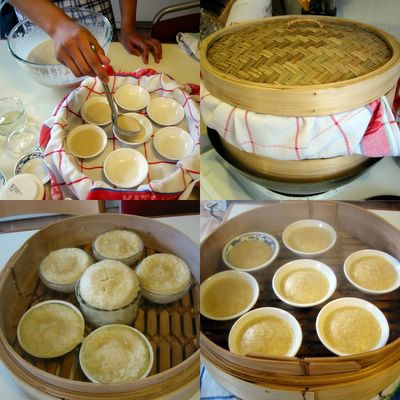
The recipe is something I got from my sister-in-law, Ate Eva, in Toronto which in turn she got from a friend of hers. I have to tone down the recipe considerably because it was cloyingly rich (nakaka-uta). The original measure of 2 tablespoons baking powder is I think too much. It actually have an slight aftertaste which I don't like so I proceeded to halve the baking powder. Same with the milk and eggs. I also added salt since I noticed that it doesn't rise as much as I want to and as you know, salt reacts with the baking powder that causes cakes to swell. As for my dreaded steaming, normally I would cover the baking pan to prevent condensation to drip on it. But since I'm using small (different sized at that) moulds, it would be truly troublesome to cover them all individually. Life is too short for me to get that tedious. So I covered the top of the steaming basket itself with a cloth. That didn't work since the water vapours came in unimpeded thru the slats at the bottom. So I moved the cloth onto the bottom of the first level basket. Finally, I had my well-risen puto (well most of the time).
 Rich Puto
Rich Puto
2 cups plain flour
1 cup milk
1 cup water
1 egg - slightly beaten
1 Tbsp baking powder
scant 1/2 tsp fine salt
1 1/3 cup sugar
- Mix all ingredients well.
- Pour into small cake moulds. (Any small ramekins or tiny bowls/plates may be used). Cover with aluminium foil, tea towels or cloth (or you may cover the steamer itself with cloth).
- Steam in medium heat for about 20-25 minutes.
- Remove from heat and pry off the puto from the moulds with a butter knife. Serve warm or cold.
*Variation: Mix grated or slivers of cheese just before steaming.
 "Chicken again?!" is my kids' gripe whenever they see a winged creature on my chopping board. I was afraid they might picket outside the kitchen to demand other food. Well, what can I do? Barring bird flu or salmonella, chicken is probably the cheapest meat you can have. We really prefer fish and other seafood but my gulay! The prices of fish here in London! No way we can afford them everyday. Unlike back in the Phils. where fish is so commonplace that people turn up their noses on galunggong (fish similar to mackerel). Getting back to my cooking, I came face to face with some chicken and this laziness to go to the supermarket for additional ingredients. Solution -> find a recipe which uses the usual cupboard ingredients or ones that I already have and voila mwala! Here comes the Chinese Cooking for Beginners by Huang Su-Huei to the rescue.
Chicken Soy Sauce
"Chicken again?!" is my kids' gripe whenever they see a winged creature on my chopping board. I was afraid they might picket outside the kitchen to demand other food. Well, what can I do? Barring bird flu or salmonella, chicken is probably the cheapest meat you can have. We really prefer fish and other seafood but my gulay! The prices of fish here in London! No way we can afford them everyday. Unlike back in the Phils. where fish is so commonplace that people turn up their noses on galunggong (fish similar to mackerel). Getting back to my cooking, I came face to face with some chicken and this laziness to go to the supermarket for additional ingredients. Solution -> find a recipe which uses the usual cupboard ingredients or ones that I already have and voila mwala! Here comes the Chinese Cooking for Beginners by Huang Su-Huei to the rescue.
Chicken Soy Sauce
500 g - 600 g chicken legs or wings - cut into bite-size pieces
1 Tbsp soy sauce
oil for deep-frying
1 potato (about 250 g) - cut into bite-size pieces
1 medium carrot - cut into bite-size pieces
1 green onion - cut into 1/2-inch pieces
1 1/2 Tbsp cooking wine
*Sauce:
1 cup water
1/2 Tbsp sugar
2 Tbsp soy sauce
*Thickener:
1 Tbsp water
2 tsp cornstarch
- Marinate the chicken in the 1 Tbsp soy sauce for about 20 minutes.
- Mix the sauce and thickener in separate containers. Set aside.
- Heat the oil in the wok and deep-fry the marinated chicken for about 4 minutes or until golden. Remove and drain briefly in paper towels. Set aside.
- Deep-fry the potatoes and carrots until golden (about 3 minutes). Drain and set aside.
- Remove the oil from the wok and then add 1 Tbsp oil.
- Stir fry the green onions until aromatic.
- Add the chicken, wine and sauce. Cover, bring to boil and simmer for 5 minutes.
- Add in the potatoes and carrots. Cook for a further 10 minutes.
- The sauce should reduce to about 1/2 cup. Stir in the thickener and bring gently to boil. Dish up and serve.

The ingredients I used here is based on what I can source in my area. So fresh coconut milk is out as with saba banana. That's one thing I miss from Pinas. The plantain, in my opinion, still can't compete with the taste and texture of the saba. But I can't find it anywhere here so to the plantain I must stick. One thing about plantain, when it's very ripe it will literally turn almost black. I was wondering before why grocers continue to display 'rotten' pieces of these. Until a Filipina friend kindly informed me that it still edible in that state. In fact, most prefer it black-ripe for a softer and sweeter banana.
I noticed as well that the sweet potatoes (kamote) here is softer or rather cooks more easily than the ones back home. And lastly, I think I prefer to use the glutinous rice flour rather than soaking the malagkit overnight then grinding it then straining it in a cheese cloth. *sigh* The ready-made flour just makes ife so much easier. By the way, there's a lot of coconut soup in this one since I love it soupy rather than chock-full of halo with hardly any soup.
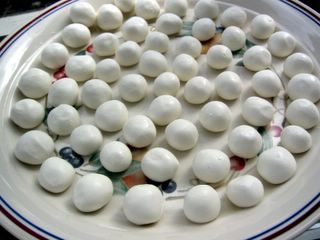 Ginataang Halo-Halo
Ginataang Halo-Halo
(Mixed Fruits In Sweet Coconut Milk)
*For the bilo-bilo (glutinous rice balls):
1 cup malagkit (glutinous) rice flour
scant 1/2 cup water
3 x 400 ml cans of coconut milk
3 x 400 ml cans of water (use the can of the coconut milk)
3/4 cup sugar
1/3 cup tiny sago (tapioca) pearls
500 g kamote (sweet potato) - peeled and cut into serving size pieces
350 g gabi (taro/eddo) - peeled and cut into serving size pieces
2 pcs ripe plantain bananas - peeled and cut into serving size pieces
250 g fresh or canned langka (jackfruit) - drained and cut into 1/2-inch thick pieces
coconut cream (optional)
- Mix the malagkit rice flour and water. Add in more water or flour to make into a dough-like consistency.
- Get a small piece off it and, with your hands, roll into a ball about 1/2-inch in diameter. Repeat until you have used up all of the dough. Set aside.
- In a big pot, tip in all the coconut milk and water. Bring to boil - watch out this mixture usually boils over.
- Add the sago pearls. Turn down heat and continue to simmer uncovered until there are no more opaque white bit in the middle of the sago pearls (about 20 minutes).
- Add in the sugar and stir to dissolve. Taste to see if the sweetness is to your liking. If not, add more sugar.
- Tip in the bilo-bilo (glutinous rice balls) in the pot. Bring to boil again until all the bilo-bilo has floated on the surface.
- Add the gabi, simmer for 3 minutes.
- Add the kamote and banana and simmer for another 4 minutes or until the gabi and kamote are almost cooked.
- Add the langka and cook for another 3-4 minutes.
- Serve hot in a bowl with 1-2 Tbsp of coconut cream on top.


Underneath the railway arches of London Bridge station, beside the Southwark Cathedral lies this small open air food shopping area called Borough Market. On this approach you can access the market through the small alley of Green Dragon Court. [Click on the pictures for a bigger view.]

I have heard a lot about it, mostly along the lines of excited chatter on great foodie finds or fresh organic produce. One fine Saturday in October I was able to verify that and I had a great time with my son foraging through the numerous stalls with loads of wonderful produce usually from small artisanal producers.
Its got a great atmosphere with lots of people mingling and craning their necks on the goods laid out on the tables. A favourite of my son is the hot apple juice laced with cinnamon. Lovely when drank in cold cold weather.
If you look closely, the place might seem familiar because it's always been a popular movie location - Harry Potter 3, Bridget Jones, Lock Stock and 2 Smoking Barrels, etc.)


In the early mornings (as in pre-dawn) the market caters more for the food/restaurant trade and wholesales. I have it from a reliable source (thanks Hanna) that it's open for retail trade on weekdays as well as on Saturdays. Fridays and Saturdays are its busiest.


Among the few things you can find there are saucisson sec (dry French sausages) of different flavours. The truffle saucisson is particularly delish. There is a stall for bratwurst and other types of German sausages, pickles, etc.


You can also find all manner of sweets, chocolates, fudges, toffees, etc. Baked goods also abound - numerous breads, cakes, pies, tarts, cookies.

I love rummaging through the stalls with fruits and vegetables where they have both organic and regular ones. You can often see unusual and hard to find vegetables that you don't normally get from your local supermarkets.
There are also a number of stalls selling food on the go - juicy hamburgers, raclette sandwiches, roast pork sandwiches, pizza (crust remained crispy!), oysters, yoghurt and others. You will never go hungry there definitely.
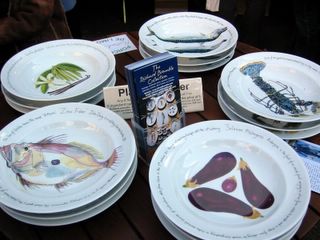
Anything food related can be found there. Just take a look at these lovely hand painted plates for sale. The same stall also sells coasters, placemats, and aprons.

Besides the temporary stalls, there are food shops, pubs, and restaurants which are open everyday since they are in permanent spaces. The restaurant (and overpriced) Fish! can be found there with a new one right above the market whose name I couldn't recall.

Among the favourite shops that I love returning to again and again are Brindisa for anything Spanish (chorizos, wines, paprika, etc.; they also have a separate tapas bar), Neil's Yard for robust breads and cheese and a branch of Konditor & Cook's for delectable cakes, cookies, and other sweet stuff.


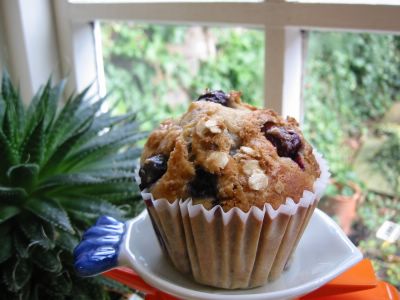 I wanted to make something to take to a family friend who recently had a spell in the hospital after an operation. He's been recovering well at his home for several weeks and I just wanted to give him a treat while at the same time not increasing his sugar and cholesterol level. Thank goodness the March 2006 BBC Good Food Magazine just went thru our letter box and contained this recipe which I think is quite wholesome. It is certainly not sweet and quite moist inside because of the fresh bananas and blueberries.
Low-fat Banana & Blueberry Muffins
I wanted to make something to take to a family friend who recently had a spell in the hospital after an operation. He's been recovering well at his home for several weeks and I just wanted to give him a treat while at the same time not increasing his sugar and cholesterol level. Thank goodness the March 2006 BBC Good Food Magazine just went thru our letter box and contained this recipe which I think is quite wholesome. It is certainly not sweet and quite moist inside because of the fresh bananas and blueberries.
Low-fat Banana & Blueberry Muffins
300 g self-raising flour
50 g porridge oats plus 1 Tbsp for topping
100 g [2/3 cup] light muscovado sugar
1 tsp bicarbonate of soda (baking soda)
2 medium bananas - mashed (about 1 cup)
284 ml buttermilk
5 Tbsp olive oil
2 egg whites - slightly beaten
150 g fresh blueberries
- Preheat oven to 180°C/fan 160°C/350°F/gas mark 4. Line a 12-hole muffin pan with paper muffin cases.
- Reserve 1 Tbsp of the muscovado sugar. Mix the rest of it with the flour and 50 gm oats.
- In another bowl, mix the egg whites, oil, and mashed bananas until well combined.
- Pour the liquid mixture into the dry ingredients and quickly stir and fold until just combined. Do not overmix.
- Add the blueberries and give it a few stirs.
- Divide the batter into the prepared muffin pans. Sprinkle the 1 Tbsp oats and 1 Tbsp muscovado sugar on top.
- Bake for 25 - 30 minutes until golden brown.
- Let cool for a few minutes in the pan then remove and cool completely.






















